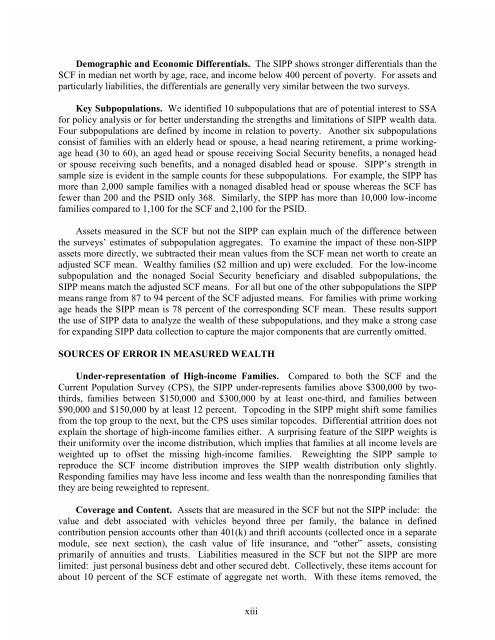Survey Estimates of Wealth - Mathematica Policy Research
Survey Estimates of Wealth - Mathematica Policy Research
Survey Estimates of Wealth - Mathematica Policy Research
Create successful ePaper yourself
Turn your PDF publications into a flip-book with our unique Google optimized e-Paper software.
Demographic and Economic Differentials. The SIPP shows stronger differentials than the<br />
SCF in median net worth by age, race, and income below 400 percent <strong>of</strong> poverty. For assets and<br />
particularly liabilities, the differentials are generally very similar between the two surveys.<br />
Key Subpopulations. We identified 10 subpopulations that are <strong>of</strong> potential interest to SSA<br />
for policy analysis or for better understanding the strengths and limitations <strong>of</strong> SIPP wealth data.<br />
Four subpopulations are defined by income in relation to poverty. Another six subpopulations<br />
consist <strong>of</strong> families with an elderly head or spouse, a head nearing retirement, a prime workingage<br />
head (30 to 60), an aged head or spouse receiving Social Security benefits, a nonaged head<br />
or spouse receiving such benefits, and a nonaged disabled head or spouse. SIPP’s strength in<br />
sample size is evident in the sample counts for these subpopulations. For example, the SIPP has<br />
more than 2,000 sample families with a nonaged disabled head or spouse whereas the SCF has<br />
fewer than 200 and the PSID only 368. Similarly, the SIPP has more than 10,000 low-income<br />
families compared to 1,100 for the SCF and 2,100 for the PSID.<br />
Assets measured in the SCF but not the SIPP can explain much <strong>of</strong> the difference between<br />
the surveys’ estimates <strong>of</strong> subpopulation aggregates. To examine the impact <strong>of</strong> these non-SIPP<br />
assets more directly, we subtracted their mean values from the SCF mean net worth to create an<br />
adjusted SCF mean. <strong>Wealth</strong>y families ($2 million and up) were excluded. For the low-income<br />
subpopulation and the nonaged Social Security beneficiary and disabled subpopulations, the<br />
SIPP means match the adjusted SCF means. For all but one <strong>of</strong> the other subpopulations the SIPP<br />
means range from 87 to 94 percent <strong>of</strong> the SCF adjusted means. For families with prime working<br />
age heads the SIPP mean is 78 percent <strong>of</strong> the corresponding SCF mean. These results support<br />
the use <strong>of</strong> SIPP data to analyze the wealth <strong>of</strong> these subpopulations, and they make a strong case<br />
for expanding SIPP data collection to capture the major components that are currently omitted.<br />
SOURCES OF ERROR IN MEASURED WEALTH<br />
Under-representation <strong>of</strong> High-income Families. Compared to both the SCF and the<br />
Current Population <strong>Survey</strong> (CPS), the SIPP under-represents families above $300,000 by twothirds,<br />
families between $150,000 and $300,000 by at least one-third, and families between<br />
$90,000 and $150,000 by at least 12 percent. Topcoding in the SIPP might shift some families<br />
from the top group to the next, but the CPS uses similar topcodes. Differential attrition does not<br />
explain the shortage <strong>of</strong> high-income families either. A surprising feature <strong>of</strong> the SIPP weights is<br />
their uniformity over the income distribution, which implies that families at all income levels are<br />
weighted up to <strong>of</strong>fset the missing high-income families. Reweighting the SIPP sample to<br />
reproduce the SCF income distribution improves the SIPP wealth distribution only slightly.<br />
Responding families may have less income and less wealth than the nonresponding families that<br />
they are being reweighted to represent.<br />
Coverage and Content. Assets that are measured in the SCF but not the SIPP include: the<br />
value and debt associated with vehicles beyond three per family, the balance in defined<br />
contribution pension accounts other than 401(k) and thrift accounts (collected once in a separate<br />
module, see next section), the cash value <strong>of</strong> life insurance, and “other” assets, consisting<br />
primarily <strong>of</strong> annuities and trusts. Liabilities measured in the SCF but not the SIPP are more<br />
limited: just personal business debt and other secured debt. Collectively, these items account for<br />
about 10 percent <strong>of</strong> the SCF estimate <strong>of</strong> aggregate net worth. With these items removed, the<br />
xiii
















